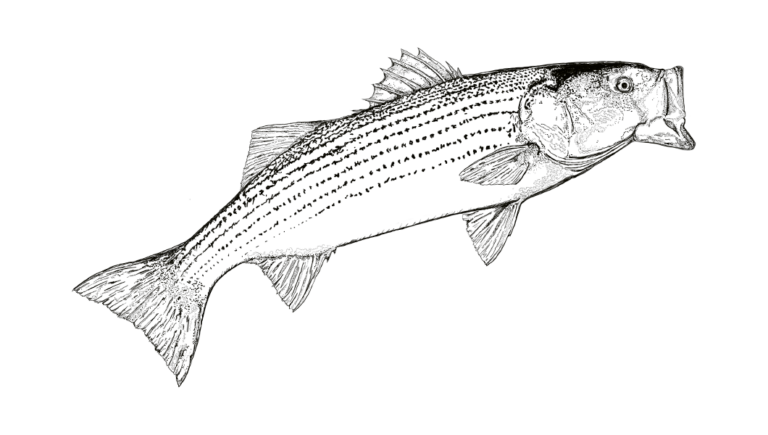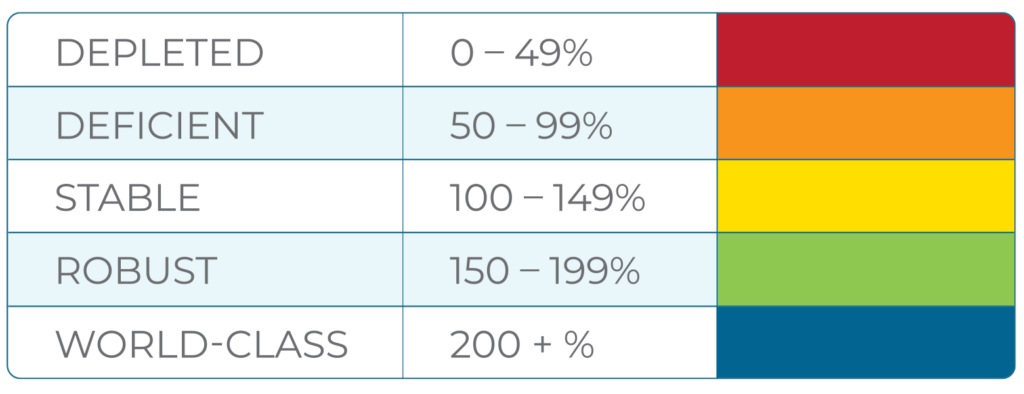Albemarle Sound & Roanoke River


1.78% = DEPLETED
How It’s Calculated
FINDEX is a novel way to gauge whether the status of a fish population is trending up or down. Management of most fish species in North Carolina is guided by stock assessment models developed by various groups of scientists. The calculations in our FINDEX metric measure the gap between the desired condition of a fish stock (the Target reference value) and the existing condition (the most recent data year in the model called the Terminal value) as determined in each stock assessment. The gaps between Target and Terminal values are reported as ratios.
For example, if the Target and Terminal values are the same, there would be no gap, and the ratio would be 1.0. The multiplier on our FINDEX barometer would set the FINDEX value at 100% in this example and assign a stock status designation of “Stable.” Categories on the FINDEX barometer are measurable as they track the extent of the gap either above or below the “Stable” designation.
For Striped Bass in the Albemarle Sound & Roanoke River area, the FINDEX gap assessment compared Target and Terminal values of Fishing Mortality (F45%) and Spawning Stock Biomass (SSB45%) from the stock assessment developed by the NC Division of Marine Fisheries. The Terminal year (the most recent data year) in the stock assessment model was 2021.
Here's the FINDEX formula used for Striped Bass:

- (0.182 x 0.098) x 100 = 1.78%
- FINDEX = 1.78% for 2021
- 1.78% = DEPLETED

FINDEX Stock Status Over Time
The stock assessment model for Striped Bass provides point estimates of Fishing Mortality and Spawning Stock Biomass for each year covered in the data set. We’ve compared the Target reference values to these annual point estimates and calculated the ratios (gaps) for each data year through the period 1991–2021. Applying the FINDEX gap assessment to the entire time series provides the following stock status trendline.
No Data Found
How Do We Get To World-Class?
FINDEX can also be used to determine when a population has reached “World-Class” status. Because FINDEX factors performance of both Fishing Mortality and Spawning Stock Biomass into the metric, multiple combinations of these values could potentially lead to a World-Class designation.
Striped Bass Target values for Fishing Mortality (0.14) and Spawning Stock Biomass (164 metric tons) have been established by the management agencies. Although the 2021 FINDEX value classifies the stock as “Depleted,” the Striped Bass population reached either “Robust” or “World-Class” status from 1994–1999, and in 2003.
If Fishing Mortality dropped to the Target value and Spawning Stock Biomass approached 330 metric tons, then the FINDEX value would again exceed 200% on our barometer. The vision of the NC Marine & Estuary Foundation is to see our coastal stocks exceed Target expectations as we pursue World-Class fisheries and thriving coastal economies.
Annual Harvest Quotas
The annual quota for Striped Bass, also called the “Total Allowable Landings” is established each year based on results from the stock assessment. The most recent stock assessment projects an annual quota for 2024 at just over 8,000 pounds.
The quota is evenly divided between the commercial and recreational sectors. The NC Division of Marine Fisheries oversees the commercial quota and the recreational quota in the Albemarle Sound Management Area, while the recreational quota in the Roanoke River Management Area is monitored by the NC Wildlife Resources Commission.
Because the projected quota was so low, the management agencies decided to prohibit all commercial and recreational harvest of Striped Bass in 2024.
You can observe the yearly quotas since 1991 in the graph provided below.
No Data Found
2024 Striped Bass Restoration Stocking Plan
Given the depleted status of the population and many successive years of poor juvenile recruitment, the management agencies have developed a restoration stocking plan for 2023–2025. During 2023, 1.5 million Striped Bass fry (2–4 days old) and 650,000 juveniles (1–2 inches) were stocked into the Roanoke River and Albemarle Sound by the NC Wildlife Resources Commission.
The fry and juvenile stockings will be repeated by the Commission in 2024. New for 2024 will be a stocking treatment of 150,000 Striped Bass sub-adults (8–10 inches) into Albemarle Sound in December. Each stocking treatment (fry, juveniles, and sub-adults) will have a unique genetic “mark” which will allow the agencies to determine the contribution of the stocked fish to the natural population over time.
The NC Marine & Estuary Foundation is excited to be able to financially support all phases of the restoration stocking project and the follow-up evaluations. To learn more about the stocking program and how the Striped Bass are produced, check out our video here.
For Harvest Seasons and Limits, visit:
- Albemarle Sound recreational regulations
- Albemarle Sound commercial regulations and detailed harvest statistics
- Roanoke River recreational regulations
State Record
- North Carolina’s coastal state record Striped Bass was landed off Oregon Inlet in 2011 by Keith Angel.
- The record-breaking fish weighed 64 pounds.
Did you know?
- A three-year restoration stocking program began in 2023 to jumpstart recovery of the Striped Bass population on the Roanoke River and Albemarle Sound. The NC Marine & Estuary Foundation is financially supporting this ground-breaking partnership.
- Striped Bass are migratory, swimming upstream from the Atlantic Ocean (through Oregon Inlet), across Albemarle Sound, and up the Roanoke River each spring.
- Spawning grounds for the Albemarle Sound & Roanoke River population are located near the Town of Weldon in Halifax County.
- The North Carolina General Assembly has formally recognized Weldon as the “Rockfish Capital of the World”.
- Striped Bass spawning occurs in late April and May, with peak spawning activity at water temperatures between 64°F and 68°F.
- River flow is critical to successful spawning; flows ranging from 6,000–12,000 cubic feet per second are optimal, allowing fertilized eggs and newly hatched fry to be transported successfully to nursery areas in Albemarle Sound.
- Drastic declines in the Albemarle Sound & Roanoke River population are primarily a result of successive poor or failed year classes following extreme spring flooding events (20,000–30,000 cubic feet per second).
- Striped Bass can live to age 30. When the age structure expands, older Roanoke River Striped Bass contribute to the Atlantic Ocean migratory population.
What’s Next?
As our team diligently refines FINDEX, we are committed to delivering the most recent stock status updates for North Carolina’s diverse finfish species. Subscribe below to receive a stream of inshore insights and stay current with our coastal initiatives.

